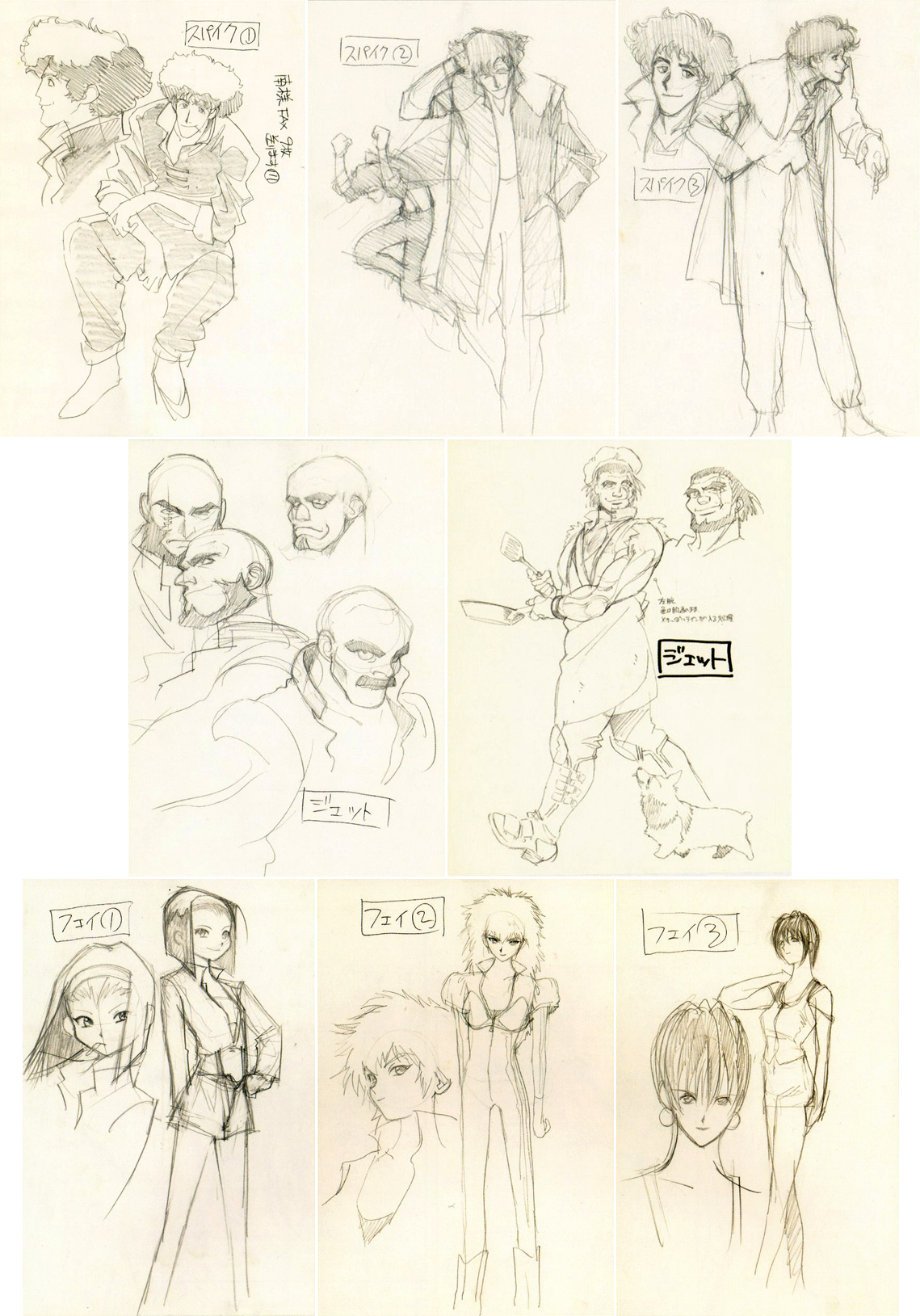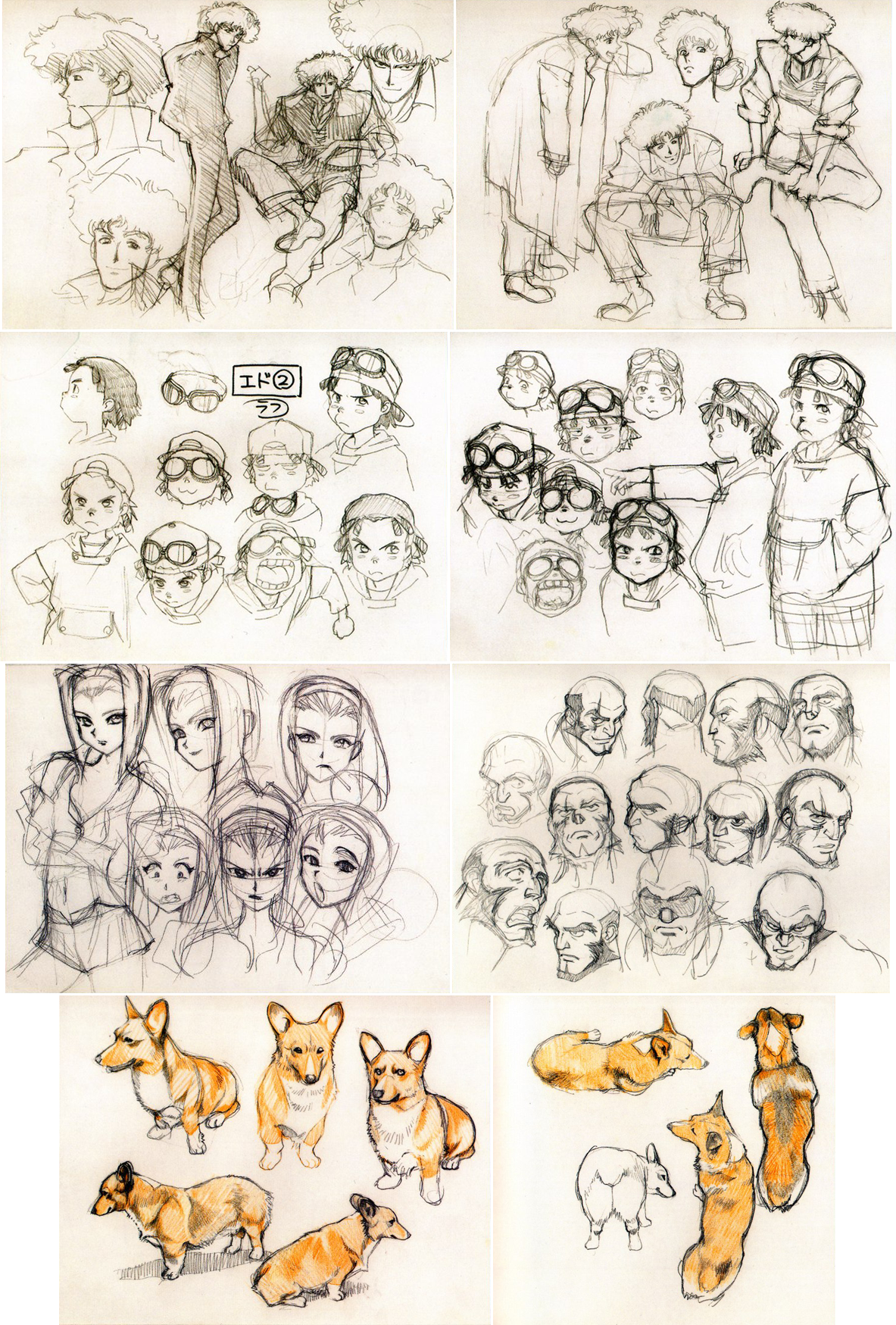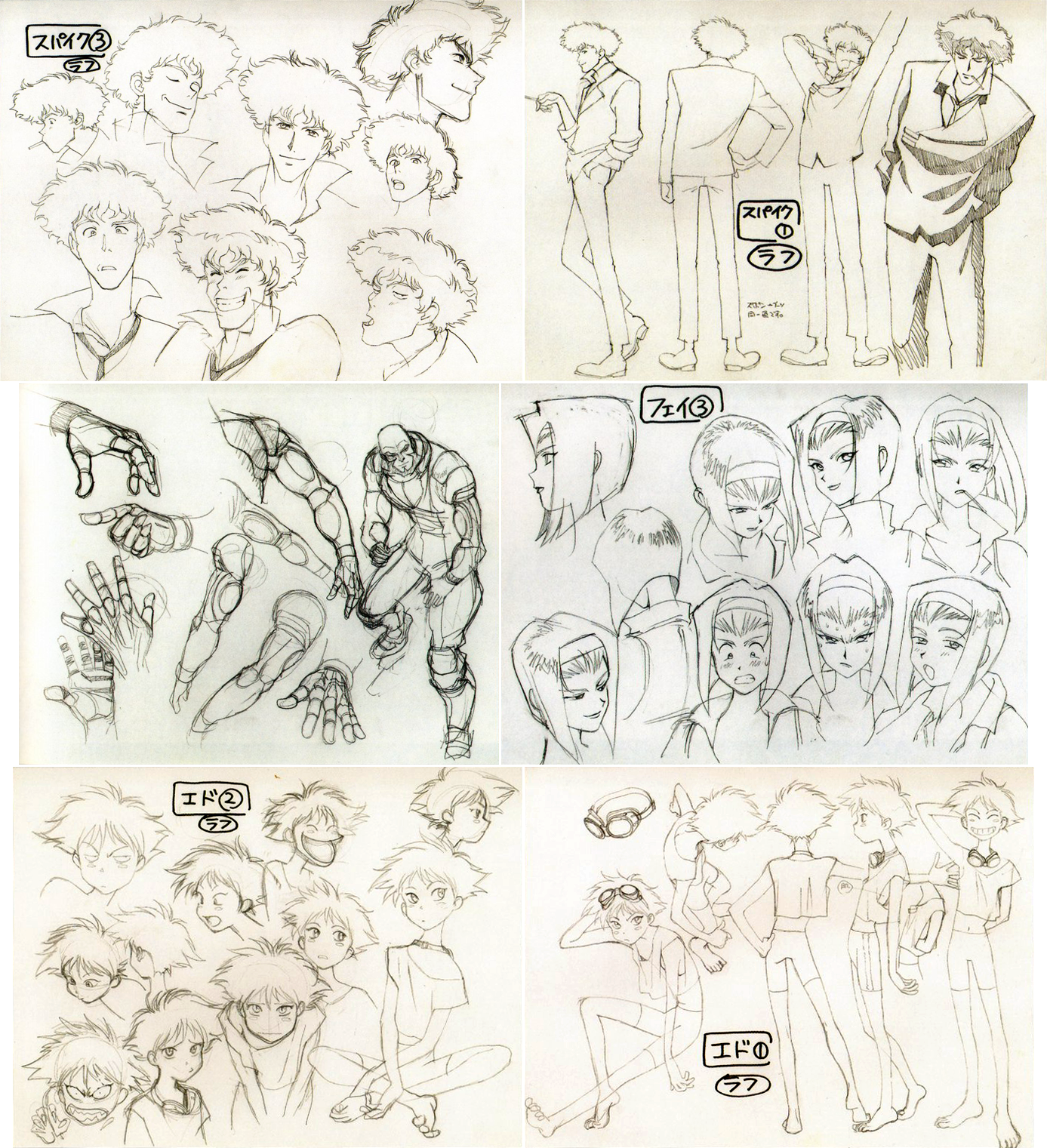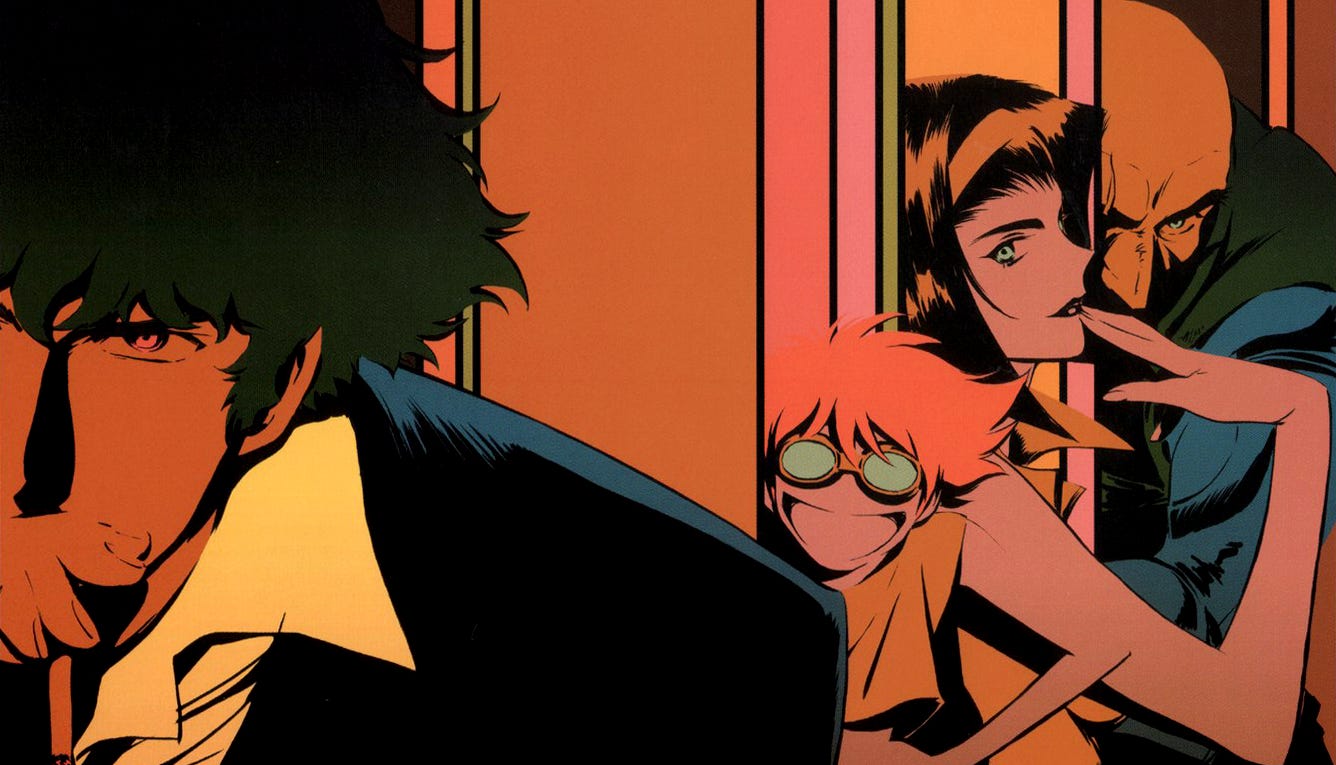Designing the Characters of 'Cowboy Bebop'
A look inside the process of character designer Toshihiro Kawamoto.
Welcome to a new issue of the Animation Obsessive newsletter! Today, we’re exploring the creation of the main cast of Cowboy Bebop — some of the most iconic characters in anime history.
If you’re new here and want to see more of our work, it’s free to sign up for our weekly Sunday issues:
Enjoy!
Everyone knows Cowboy Bebop. It was a global hit — in places like the United States, it’s still viewed as a definitive work of anime.
The series may be 24 years old, but the love endures. When its live-action reboot failed last year, it was a reminder — even now, we’re all attached to the original. There’s something special about Cowboy Bebop that can’t easily be recaptured.
A lot of that specialness came from the crew involved. Cowboy Bebop’s director, Shinichirō Watanabe, delegated work. He gave the staffers at the Sunrise studio enough room to put themselves into the show. “As a director, there are times when I don’t feel like dealing with details,” he said.1
Plus, Watanabe felt that the project would suffer unless the people making it had fun. Creative freedom engaged them. The late Keiko Nobumoto, Cowboy Bebop’s lead writer, recalled the production as “freewheeling.” Character designer Toshihiro Kawamoto said, “Each person steadily put out what they liked, and got it in the show.”
Which is how Cowboy Bebop’s famous characters Spike, Jet, Faye, Ed and Ein came to be.

In 1996, Cowboy Bebop started pre-production as the thinnest sketch of an idea. Kawamoto was hired by the producer to flesh out the project by designing the three main characters — the first step away from the rough outline and toward a real show.
As Kawamoto wrote:
The working title of the project was Shooting Star Bebop. At that time, the production of Star Wars Episode I had been announced. So we had action in space with spaceships in our mind. Director “Nabeshin” (Shinichirō Watanabe) had provided some rough direction as well as the concept of the title: to focus on characters mixed with stylish music. From the world setting in the planning document written by the chief scriptwriter of the show, Ms. Keiko Nobumoto, we solidified the characters.
The early meetings were inconclusive, but Kawamoto got the general idea that the characters should feel hardboiled. Still, he didn’t have much material. “ ‘Just draw something to start off with,’ I was told by the producer,” Kawamoto recalled, laughing.
That producer, Masahiko Minami, had faith in Kawamoto’s ability to improvise. They’d spent years working together on Gundam — Minami said that Kawamoto excelled when following his own ideas, and always delivered drawings that have “a strong sense of presence and are very eye-catching.”
So, Kawamoto began to sketch, getting input from Watanabe, Minami and Nobumoto along the way. Silhouette and contrast were key considerations.
Spike was basically there from the initial drawings. “In very general, vague terms, he’s a combination of ‘Space Lupin’ and City Hunter,” Kawamoto explained. Faye and Jet were further off. With Faye, he drew a series of tests for a “casual, a space-age cosmo look or [a] sexy” direction — and some are unrecognizable.
Jet was closer than Faye, but still a little weird. Many of his early versions had mustaches. One key thing that didn’t change was the presence of Ein by his side. (“I’ve put a Welsh corgi by Jet’s legs, a request from Ms. Nobumoto,” Kawamoto wrote about an early drawing.) Ein’s eventual model was a corgi named Billy, owned by one of Kawamoto’s friends.
The most remarkable difference between the early Cowboy Bebop designs and the final ones wasn’t Jet or even Faye, though. It was Ed. As Kawamoto noted, “Ed was a boy at the planning stage.”

Ed’s first iteration was still a young hacker — but clearly not the same character. Watanabe was the one who suggested a change. He’d worked with composer Yoko Kanno on Macross Plus, another anime project, and found her to be a highly unusual person. That was his inspiration. Watanabe put it this way during a panel:
Before Cowboy Bebop, I met this composer. And the composer was female and very eclectic. And during the production, she would kinda just roll around on the floor and do very strange things. And on occasion she would make strange noises. I thought it would be interesting if I could put her in as a character in my next series.
It was sort of a last-minute tweak. At the time, Spike, Faye, Ein and Jet were close to finished — and the first episode of Cowboy Bebop was about to enter production. But Ed wasn’t scheduled to appear until the ninth episode, so Kawamoto believed that there was time. He later wrote:
The director told me that the image he had for Ed was Ms. Yoko Kanno. She was always lying around in the mixing room (laughs). The only image I had of her at that time was still as the composer for Macross Plus and Escaflowne, someone who conducts an orchestra, you know. So what I was told didn’t make sense to me. Yet I drew something of a genius with a cat-like image, trying to combine what I heard. Ed was turned into a girl at this stage.
Kanno herself joined Cowboy Bebop — she recalled being shown the version with the original four characters, before Ed’s redesign. There wasn’t much to the show concept yet. In fact, she was famously unimpressed by the whole pitch.
“At first, I got a slim planning book with little content,” she said, “no proper title and a large collection of characters [...] and I told the other staff, ‘This animation definitely will not sell.’ ”

Although he received feedback along the way, Kawamoto was very much in his zone as he designed the cast. Watanabe remembered him as someone who could do a lot with little direction. The look of Cowboy Bebop’s main characters comes from Kawamoto’s sensibility.
It was a sensibility he’d been refining since his Gundam days. “I thought that the character designs for [Gundam] 0083 were too detailed,” he said, “and I wanted to change that.” By the time of Cowboy Bebop, he noted that he’d “reduced the number of lines and made it more simple” — a style he compared to Hayao Miyazaki’s work.
Referencing other anime was normal for Kawamoto. As he designed Cowboy Bebop’s characters, he borrowed freely from projects he enjoyed. He had an undramatic view about it. In Kawamoto’s words:
Your work always reflects what you’ve seen and what you like. It is said that Bebop has similarities to Lupin and Crusher Joe, but I like those works and watch them, so it can’t be helped.
Wholly original or not, Kawamoto brought his own spin to these ideas. Even though you can see his influences, Cowboy Bebop’s characters ultimately don’t look like they could’ve appeared in Lupin III, or anywhere else. They’re special.
And the team could tell. Yoko Kanno was amazed by how unique each character looked — and said that she wanted to marry Spike. Keiko Nobumoto, whose writing gave life to Kawamoto’s designs, had only positive things to say about his work. In 2004, a few years after the show and film had wrapped, she wrote this:
On the set of a live-action movie, someone always says, “Actors nowadays have no depth in their performances.” It’s true; there are fewer and fewer actors these days who can bring imagination to their roles. No matter what, the role feels flat and not three-dimensional.
And during an animation production, someone always says, “No one can draw subtle expressions.” Is that so? But their expressions are so rich. Of course, I’m referring to Spike and the others.
The characters drawn by Kawamoto-san are all alive. It’s not that they are the same as living people, but that these characters are all three-dimensional. For example, the back view. Looking at the back, you want to see his expression, and you imagine what he looks like. You imagine his past and future.
In the flat world of animation, these characters are shaped into three dimensions. They may even be more lifelike than real people.
During the production of Cowboy Bebop, I had a lot of discussions with director Watanabe about the characters. We wanted the characters to be multifaceted. From the script to the creation of the image, everything was directed toward this goal.
Spike’s breath probably smells like cigarettes. I often have this feeling. Maybe it’s just my personal impression.
The people on the Bebop are alive, and they have different pasts, so what kind of lines will they say? It’s really interesting to think about this. A character with a good side and an evil side, who will be confused, who is at times pure and honest.
Such coarse and smelly characters could only be drawn by Kawamoto-san.
I hope I have the opportunity to meet with them again. With Spike, Jet, Faye, Ed and Ein. But maybe it’s better not to meet again. It’s been so long, and as we’ve grown older, and experienced many things, I think they will also have changed a lot. They aren’t just characters in an animation. The people in Cowboy Bebop are never just that.
Thanks for checking out today’s issue! We hope it’s been as much fun to read as it was to research.
If you’re a reader who’s not yet a member, we publish new issues exclusive to members every Thursday. That includes dives into anime classics like Princess Arete, a film by the assistant director of Kiki’s Delivery Service.
Only members make it possible to keep this newsletter going. In return, they get exclusive access to some of our best stuff. Find the details on our subscription page:
Note that we offer a 40% discount to students and educators. If you’re a teacher looking for an even deeper bulk discount for a class, let us know.
See you again soon!
From the book Cowboy Bebop: The After. We also rely heavily on Cowboy Bebop: Illustrations ~The Wind~.



This is an article I've been meaning to read for awhile. My current first novel project is heavily inspired by Cowboy Bebop and I liked this article because it gives me further insight into character designs and elements. It's something hard to capture in writing, but with just enough sauce from your ingredients, it might be possible!
Thank you!
Wonderful article. I think it's easy to imagine settei dropping fully formed from the mind of the character designer - this part of the design process is too rarely discussed. It's really cool to see what the rough drawings look like, and know the story behind Ed.